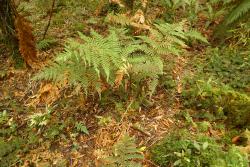- ≡ Balantium lanatum (Colenso ex Hook.) Fée, Mém. Foug., 5. Gen. Filic. 341 (1852)
Rhizomes either prostrate, up to 50 mm diam., branching and stoloniferous, or erect, forming a woody trunk 0.2–2 m tall, 50–150 mm diam., covered in brown adventitious roots and brown stipe bases; lacking buds, bearing red-brown multicellular hairs near the apex. Fronds 400–2000 mm long, held erect, falling when old; dead fronds orange-brown. Stipes 210–1170 mm long, red-brown at very base, becoming chestnut-brown or yellow-brown or green distally, or occasionally green throughout, smooth, often bearing fine golden-brown hairs at the junction with the rhizome, densely covered in red-brown multicellular hairs up to 35 mm long proximally, and pale brown or chestnut-brown hairs to 8 mm long distally. Laminae 2-pinnate-pinnatisect to 3-pinnate (sterile pinnae) or 3-pinnate-pinnatifid (fertile pinnae), ovate or triangular, 240–1130 mm long, 140–700 mm wide, coriaceous, smooth, abundantly hairy on abaxial surfaces of rachis, pinna midribs and costae; hairs more or less straight and rigid, interspersed with shorter fine hairs, or in dense woolly patches; rachis yellow-brown or green. Primary pinnae in 13–23 pairs, ovate, narrowly ovate, triangular or narrowly triangular; the longest below the middle, 95–425 mm long, 35–165 mm wide, stalked; the basal pair 100–340 mm long. Secondary pinnae narrowly ovate or narrowly triangular, the longest 20–85 mm long, 7–25 mm wide, stalked. Longest tertiary pinnae 3–14 mm long, 1.5–6 mm wide, stalked or sessile or adnate, the fertile ones divided more than halfway to midrib; ultimate segments slightly rounded. Sori terminating veins at margins of lamina, ovate, 1–2 mm long, slightly elongated along the lamina margin.
Dicksonia lanata has smooth fronds and ovate or triangular laminae. It has two distinct subspecies (Brownsey & Perrie 2014). One is a short-trunked plant found principally in kauri forests north of Auckland. It is distinguished from D. squarrosa by its brown rather than almost black trunk and stipe bases, and also lacks the orange-brown dead fronds and aerial buds of that species. It is distinguished from D. fibrosa by its narrower trunk and lack of a skirt of dead fronds. The second subspecies is very distinctive in being a prostrate plant, lacking a trunk. It produces stolons and grows as thick, tangled colonies.
North Island: Northland, Auckland, Volcanic Plateau, Gisborne, Taranaki, Southern North Island.
South Island: Western Nelson, Sounds–Nelson, Westland.
Altitudinal range: 10–1400 m.
In the North Island D. lanata occurs in coastal and lowland forest from North Cape to Coromandel, and in montane forest or open scrub from Thames south to the Ruahine Ranges, with an outlying population in the southern Tararua Ranges. It is apparently absent from much of Taranaki, the Tararua Ranges and the east coast, although there is a single dubious record from Mt Egmont (WELT P005570, without collector, date or specific locality). It occurs from near sea level to 1100 m in the Urewera region and 1400 m in the Ruahine Ranges. In the South Island it grows mainly in coastal and lowland forest, occurring on Mt Stokes in the Marlborough Sounds, and along the west coast from north-west Nelson to Lake Moeraki, South Westland. It reaches 750 m above Boulder Lake, north-west Nelson.
In the northern part of its range it occurs in lowland kauri, podocarp or taraire forest, in mature mānuka or kānuka scrub, and occasionally in gumland. South of Thames it is found in open scrub, and in podocarp, beech or broadleaved forest.
| Category | Number |
|---|---|
| Indigenous (Endemic) | 2 |
| Total | 2 |
n = 65 (Brownlie 1961)
As with D. fibrosa, this species was first collected by Colenso during his journey through the Urewera Ranges in 1841–42, and later published as D. lanata in the Tasmanian Journal of Natural Sciences (Colenso 1845). Until recently, this has been accepted as the earliest validly published description (Brownsey et al. 1985). However, Colenso sent a specimen (No. 271) and copy of an unpublished description to W.J. Hooker in a letter dated 1 September 1842 (see St. George 2009). Hooker then used Colenso's specimens and descriptions to draw up his own description for inclusion in Species Filicum (Hooker 1844–1846). He attributed the name to Colenso, and cites Colenso’s article in the Tasmanian Journal of Natural Science. Hooker did not intend to pre-empt Colenso, expecting Colenso's description to have been published before his, but in the event Species Filicum appeared in print first, and is the first validly published description for the species. Because, in this case, Hooker attributed only the name to Colenso, without any part of Colenso’s description, the species must be cited as D. fibrosa Colenso ex Hook. (K. Gandhi, pers. comm. – Art. 46). The specimen collected by Colenso from the shores of Waikare Lake in December 1841 (WELT P003258), and cited by Allan (1961) as the type, was not seen by Hooker and therefore cannot be considered part of the original material.
Dicksonia laevis Heward in Hooker (1844), cited in the synonymy of D. lanata, is a nomen nudum.




